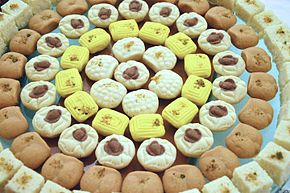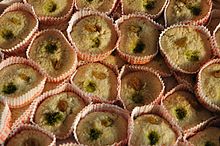Sandesh (confectionery)
 | |
| Course | Dessert |
|---|---|
| Place of origin | Indian subcontinent |
| Region or state | Bengal region of the Indian subcontinent |
| Associated cuisine | India, Bangladesh |
| Main ingredients | Chhana / paneer, sugar, jaggery (gur), condensed milk |
| Variations | Nolen gure sandesh, narom pauk sandesh, koda pauk sandesh, various flavorings |
Sandesh (Bengali: সন্দেশ Shôndesh; Template:Lang-syl Handesh; Hindi: संदेश) is a dessert, originating from the Bengal region of the Indian subcontinent, created with milk and sugar.[1][better source needed] Some recipes of Sandesh call for the use of chhena or paneer (which is made by curdling the milk and separating the whey from it) instead of milk itself.[2] Some people in the region of Dhaka call it pranahara (literally, heart 'stealer') which is a softer kind of sandesh, made with mawa and the essence of curd.[3]
History
A sweet dish by the name sandesh is mentioned in medieval Bengali literature, including Krittibas' Ramayana and lyrics of Chaitanya. However, the ingredients of this original dish are not known.[4] This dish was most likely different from the modern chhena-based sandesh, being made of solidified kheer.[5][6]
It is hard to determine when exactly sandesh started referring mainly to the chhena-based sweet instead of the kheer-based sweet. But it is known that by the second half of the 19th century, sandesh commonly referred to the chhena-based sweet.[7] The Portuguese influence may have led to introduction of cheese (i.e. chhena) in sixteenth century.[4]
Preparation

Sandesh can be made with the use of chhena or cottage cheese. The simplest kind of sandesh in Bengal is the makha sandesh (makha = kneaded). It is prepared by tossing the chhena lightly with sugar over low heat. The sandesh is essentially hot, sweetened chhana. When shaped into balls, it is called kanchagolla (kancha = raw; golla = ball). For more complex and elaborately prepared sandesh, the chhana is dried and pressed, flavored with essence of fruits, and sometimes even colored, and cooked to many different levels of consistencies. Sometimes it is filled with syrup, blended with coconut or kheer, and molded into a variety of shapes such as conch shells, elephants, and fish. Another variant is nolen gurer sandesh, which is made with gur or jaggery. It is known for its brown or caramel colour that comes from nolen gur.
References
- ^ Sandesh
- ^ Nirmal Sinha (2007). "Chhana". In Y. H. Hui (ed.). Handbook of Food Products Manufacturing, 2 Volume Set. Vol. Volume 2. John Wiley & Sons. p. 643. ISBN 978-0-470-11354-7.
{{cite book}}:|volume=has extra text (help) - ^ Ken Albala, ed. (2011). Food Cultures of the World Encyclopedia. Vol. Volume 1: Africa and the Middle East. Santa Barbara, Calif.: Greenwood. p. 34. ISBN 978-0-313-37627-6.
{{cite book}}:|volume=has extra text (help) - ^ a b Meenakshi Das Gupta; Bunny Gupta; Jaya Chaliha (2000). Calcutta Cookbook: A Treasury of Recipes From Pavement to Place. Penguin UK. p. 338. ISBN 9789351181491.
- ^ Harlan Walker, ed. (2000). Milk - Beyond the Dairy: Proceedings of the Oxford Symposium on Food and Cookery 1999. Oxford Symposium. p. 57. ISBN 978-1-903018-06-4.
- ^ Michael Krondl (2011). Sweet Invention: A History of Dessert. Chicago Review Press. pp. 55–59. ISBN 978-1-55652-954-2.
- ^ Chitrita Banerji (2006). The Hour of the Goddess: Memories of Women, Food, and Ritual in Bengal. Penguin. pp. 117–120. ISBN 978-0-14-400142-2.
External links
- Sweetmeats in Banglapedia




